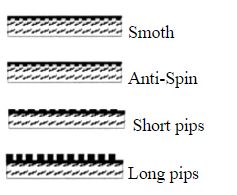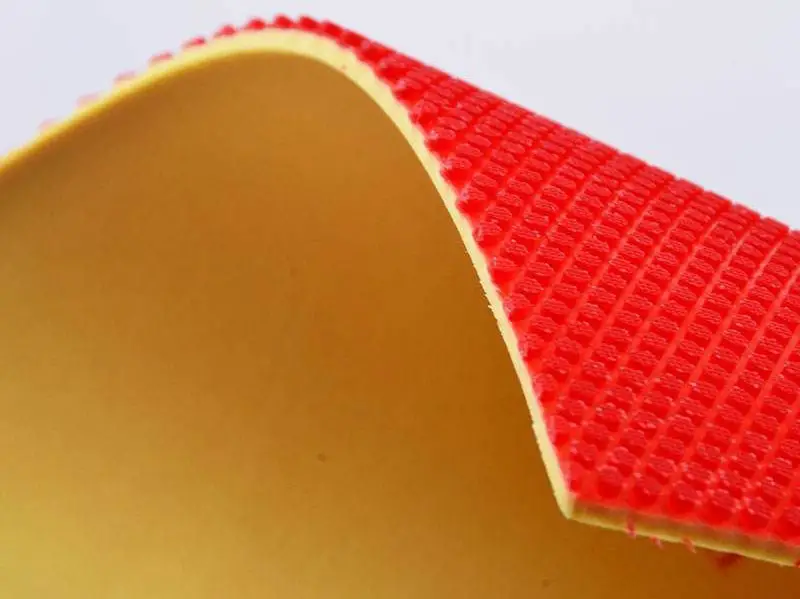When buying table tennis rubber, we will find that there are two important parameters on the packaging of the rubber, one is the hardness of the sponge, and the other is the thickness of the sponge.
For players, they need to know the influence of the thickness of the sponge on the rubber, and what thickness of rubber should players with different playing styles choose when picking the table tennis rubber.
4 Rubber Types
Generally, there are 4 rubber types you can find when you go to pick a table tennis rubber. They are smooth, anti-spin, short pips, and long pips.
Smooth
The particles of pips face inward and the smooth side faces outward. It has a high viscosity and high friction, which is easy to make a strong spin. For players who like to play arcs and chop, it is the most suitable rubber choice. It is also the most commonly used type of rubber for most table tennis players.
Anti-Spin
The characteristic of anti-spin rubber is that it can hit the ball quickly and steadily, and it can also create a good spin. When the rubber is in contact with the ball, it is mostly a direct hit. It can give players less friction, which is suitable for close-table offensive play.
Short Pips
The particles are slightly shorter. The main characteristic of the rubber is it can give players very good control over spin. It can make an erratic shot to the opponent. Sometimes it can be hard for a player to play with short pips rubber. However, once you get familiar with the characteristics of the rubber and master the skill, it can be a powerful tool for you to play with it.
Long Pips
The long pips rubber featured long and slender particles. It is softer than short pips and the particle’s surface is face outward. The long pips rubber is generally used by players with chopping and defensive styles. Basically, it depends on the incoming ball to determine the spin intensity of the returning ball and then produces the opposite rotation. This style of play makes it difficult for opponents to return the shot.
The Thickness Of The Sponge
The thickness of the sponge is relatively uniform in the products of various manufacturers, and the thickness is measured in millimeters. If you take a look at the table tennis rubber, you often see the words 2.0mm, 2.1mm, 2.15mm, and 2.2mm on the rubber packaging.
Different types of rubber sponges have different thicknesses. The thickness of the sponge of the backhand rubber is generally between 1.8mm and 2.3mm, and the thickness of the rubber of the forehand rubber is generally between 1.5mm and 2.2mm. The long pips is having a thickness between 0.4mm and 1.0mm.
The most popular rubber is mainly backhand rubber, which is generally available in three types of thickness which are 1.8, 2.0, and MAX. You can find the measurement on the packaging. The so-called MAX usually refers to the 2.2mm thickness of the rubber. However, no matter how thick the sponge is, the total thickness of the sponge and rubber should not exceed 4.0mm.
5 Strategies
Rubbers are classified into five (5) strategies. Analyze your style of play and determine your predominant strategy compared to others. Then, choose the rubbers that are ideal for you.
1) Defensive/Control: Style centered on defense strategies with occasional offensive shots. For a safe style with precise ball placement. Rubber with excellent ball control.
2) Allround/Control: Style centered on the variation of control shots: pushes, chops, safe blocks, and counter-attack tactics.
3) Allround/Active: For the all-around player with emphasis on controlled topspins and offensive blocks.
4) Offensive/Control: Style centered on topspin attacks with speed and trajectory variations.
5) Offensive/Aggressive: Very fast rubber for a fast topspin and smash style. Steady and intensive training is necessary to maximize the use of these rubbers.
A few tips
* You need one red and one black rubber.
* Choose the thickness of the sponge according to your style of play. The thicker the sponge-the faster the rubber. The more spinny a rubber is, the more it will react to the opponent’s spin.
When Should Rubbers Be Changed?
* Elasticity and stickiness of rubbers diminish with use and with age. During use, dust particles penetrate the rubber causing it to lose its stickiness. Also, exposure to heat, light, and air diminishes the qualities of the rubber. As the rubber’s characteristics change, the player must adapt his technique. This means that more effort is needed to execute the same shot. As well as being unpleasant, this may hinder precision and playing level. That’s why utmost care is recommended for your equipment.
* The power and the spin that a player can produce are two other major factors that contribute to the “normal” use of the rubber. You’ll notice a difference between the stickiness of the center of the rubber (the section used to hit the ball) and the outer part of the rubber.
* You should change your rubber when it’s no longer capable of producing the spin and speed you require. As a reference: the average world-class player changes his rubber after about 30 hours of play, approximately every week. A player who practices and takes part in tournaments can use his rubber for around 75 hours, approximately 2 to 3 months. A recreational player can use his rubber for around 150 hours, approximately 6 to 12 months. An occasional player can use the same racket all his life! Pips out and anti-spin rubbers usually last longer than smooth rubbers.
The Effect of Rubber Thickness
My friend and I have carried out an experiment by playing ping pong with different rubber thicknesses. The average speed of the backhand rubber with a sponge thickness of 2.1 mm is 107.4 rpm, and the average speed of the backhand rubber with a thickness of 1.3 mm is 99.2 rpm. A sponge with a thickness of 2.2 mm has a rebound height of 194 mm; a sponge with a thickness of 1.79 mm has a rebound height of 187 mm.
From the above experimental results, we observed that the spin of the sponge with a higher thickness can offer us more spin than that of the thinner sponge, which is caused by the difference in the elasticity of the sponge.
Therefore, we have come to the following conclusion: the same type of rubber with different thicknesses of sponge rubber has a significant effect on the spin of the ball. Under the conditions allowed by the rules, the thicker the sponge, the greater the elasticity, and the more spin it can generate; the thinner the sponge, the less spin the rubber can generate.
Also read:


